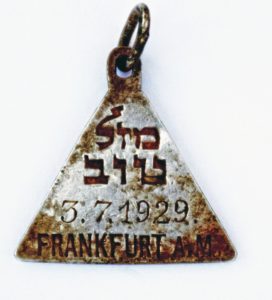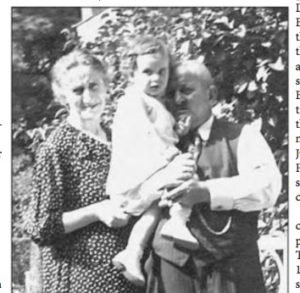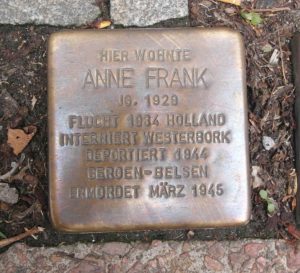It was 75 years ago this summer that a young Jewish girl named Anne Frank started keeping a diary in Amsterdam in the Netherlands. During the course of her diary, the teen ager would be forced into hiding in a small, secret apartment over a jam warehouse. On Aug. 1, 1944, she made her final entry, just days before her family was discovered by the Nazis and sent to concentration camps where Anne, her mother and her sister all died. But Anne’s father, Otto Frank, survived, and so did Anne’s diary.
The book has become a standard part of how American young people learn about the Holocaust through the eyes of someone who could have been their peer.
My family and I visited the secret annex where Anne and her family hid in Amsterdam on Easter Sunday in the spring of 2008 while we were visiting our eldest who was on student exchange in Germany for the year. Here’s an excerpt of what my wife, Pam, wrote about the visit:
“Easter Sunday we took the train to Amsterdam and visited the Anne Frank house. Erik had gotten us tickets on the Internet so we could bypass the long lines waiting in the falling snow.
“A videotaped interview with Otto Frank played as the queue filed through the last of the cramped twisty quarters. His words still resonate. He spoke of his daughter being a ‘typical’ teenager. I marveled that I never knew the ‘house’ where the Franks and others hid was actually quarters above a jam warehouse. It wasn’t important to Anne so she didn’t feel the need to mention it. I tried to imagine what life must have been like, especially for the children, never being able to go outside or make noise during the day for fear of exposure. Otto Frank spoke of what an ordinary teenager she was, and that’s what made her so extraordinary.
“Anne Frank was somebody’s daughter. She could be cantankerous and fight with her mother and sister and dream of kissing a boy. She didn’t get to grow up. She didn’t get to see the world.”

A pendant that appears to be almost identical to one that belonged to Anne Frank (Yoram Haimi, Israel Antiquities Authority)
Anne’s impact on the world has not diminished over the decades. This last January a pendant was found by archaeologists at the Sobibor Polish death camp. The pendant said Mazal Tov in Hebrew, had the date July 7, 1929, and the location “Frankfurt A.M.” According to a database of people who were deported during the Holocaust, the pendant might have belonged to Karoline Cohn, a Jewish girl born in Frankfurt on that date.
The thing that makes this pendant particularly interesting is that Anne Frank had one almost identical to it – the only difference being that Anne’s had her birthday on it – three weeks apart from Karoline’s. Might the two girls have known each other? That’s a question researchers will try to establish.

Your blogger with Dr. David Gradwohl from a recent visit.
The story fascinated me because I’ve got a lasting interest not only in Anne Frank, but also in archaeology. In fact, I double majored in journalism and anthropology (emphasis archaeology) as an undergrad. So when I saw this story, I passed it on to my archaeology professor Dr. David Gradwohl, now retired from Iowa State. While David grew up in Lincoln, Nebraska, his lovely wife Hanna was born in Nazi Germany, and her family escaped to Lincoln in 1937. Here’s what David had to say to me about the pendant story:
Interestingly enough, I heard about this from a German acquaintance, Ute Müller, who has visited Sobibor several times. On her most recent visit to that infamous site, she spoke with the Polish and Israeli archaeologists who were excavating the site. They showed her that metal tag which they had just found the day before her visit! She did some research and helped identify the owner of the tag, Karoline Cohn, a young girl who had lived in Frankfurt am Main.
O.K. the web gets even more tightly woven. Ute Müller is the daughter of Hans Bruno Venema who, in 1942, was a boy living in Frankfurt in the same apartment house as Hanna’s paternal grandparents (Benno and Hedwig Rosenberg) and great uncle (Julius Speyer). Hans Bruno remembered Hanna’s grandparents and great uncle, who were “deported” from Frankfurt in 1942 and sent to Theresienstadt. Julius was murdered there. Benno and Hedwig were sent on to Treblinka and murdered there. In the letters we are translating/getting translated, Benno, Hedwig, and Julius mention the Venema family, and especially Hans Bruno’s little sister Bärbel who reminded them of Hanna, their granddaughter whom they would never see again. As you know, Hanna was born in Germany in 1935 and escaped with her parents to Lincoln, NE, in 1937.
In 2015, Hans Bruno Venema sponsored the setting of “stolpersteine” in Frankfurt, in memory of Benno, Hedwig, and Julius.
So, what is a stolpersteine? We’ll let Hanna explain with her article published in the Omaha Jewish Press:
Since 1995, the German artist Gunter Demnig has been crafting and setting “Stolpersteine” in memory of civilians murdered by the Nazis during the Holocaust. The term “Stolpersteine” literally means “stumbling blocks.”
Demnig selected this designation because in pre-World War I Germany, it was a custom for non-Jews, if they stumbled along a cobblestone-paved street, to say, “There must be a Jew buried here.”
These memorials consist of concrete blocks, approximately four inches square, covered with a sheet of brass. On these brass plates, Demnig stamps the words “Hier wohnte” (here lived), the name of the victim, his or her birth date, date of deportation, and place and date the victim was murdered by the Nazis. If possible, the Stolpersteine are placed flush with the sidewalk in front of the last place the individual voluntarily resided.
Demnig set the first Stolpersteine in the city of Cologne in 1995. Since then, over 50,000 of these memorials have been installed, primarily in Germany, but also in Austria, the Netherlands, Belgium, Italy, Hungary, Poland, Ukraine, Norway, and the Czech Republic. Although most of the Stolpersteine have been set in memory of Jews, Demnig has also installed these memorials for other victims of the Holocaust.
On Sunday, May 17, 2015, Gunter Demnig set three Stolpersteine in Frankfurt, Germany, in memory of my paternal grandparents, Bernhard “Benno” Rosenberg and Hedwig Speyer Rosenberg, and my great uncle, Julius Speyer.
It is fascinating to me how often Anne Frank’s legacy keeps popping up in my research. Several years ago I wrote a post about the Anne Frank graphic novel biography published back in 2010 as well as about an updated edition of her diary. (Earlier editions left out some of the unkind things Anne said about her mother and some details about Anne discovering her sexuality.)
These are stories that live on; they are not just history, they continue to be part of our lives today.
Thank you, Hanna and David, for letting me share your stories here.




Thank you for sharing this story, Ralph! I got the information about your blog from David, my favorite foreign correspondent from Iowa 😉
We are all connected, beyond borders!
Greetings from Germany
Ute Müller
Thank you so much for your kind words, Ute! And thank you for your work on this fascinating history.
Pingback: The story of stolpersteine lives on | Living in a Media World